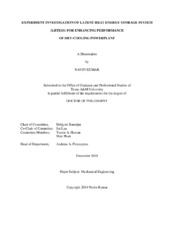| dc.description.abstract | Conventional electric power production primarily relies on water as a coolant - to remove low grade heat from the steam exiting from the turbines in thermal power-plants. It is anticipated that in the near future - these conventional techniques for water cooling of thermal power-plants will become unsustainable in various geographical regions that have scarcity of water resources. This is expected to arise from a combination of environmental concerns, increased water demand due to population growth, and the impact of climate change. Therefore, air-cooled platforms (dry cooling systems) are the obvious option for the replacement of water-cooled platforms. However, dry-cooling systems suffer from several performance limitations that compromise their reliability. Supplemental cooling systems can enhance the operational reliability and thermal performance of dry cooling systems. Hence, a latent heat thermal energy storage system (LHTESS) was developed and validated in this study as a proof of concept for a supplemental cooling system. The goal of this study to is to demonstrate the viability of LHTESS as a supplemental cooling platform with the aim of improving the energy efficiency and thermal performance ratings of air-cooled systems.
To improve the operational reliability of the LHTESS explored in this study, different phase change materials (PCMs) were explored (with and without additives). Both organic (e.g., paraffin) and inorganic (e.g., salt hydrates) materials were explored as candidate PCMs.
Material stability of the candidate PCM samples and additives were analyzed by subjecting them to thermocycling: consisting of repeated cycles of melting and freezing. Corrosion experiments were performed for evaluating the material compatibility of the chosen list of PCMs with candidate materials used in construction of LHTESS.
The incorporation of candidate PCMs in various heat exchanger configurations and validating their thermal performance was performed to meet the deliverables specified by the
sponsor of this research study, as part of the ARID program (Advanced Research in Dry-Cooling) of ARPA-E (Advanced Research Programs Agency – Energy). The different heat exchanger configurations explored in this study are: shell-and-tube heat exchanger (using Additive Manufacturing techniques, i.e., 3-D Printing), chevron-plate heat exchangers and a compact heat exchanger. Thermal conductivity enhancement techniques were explored by incorporating aluminum mesh as a metal foam in the compact heat exchanger. | en |


